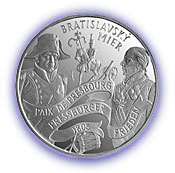-
NBS Tasks
Browse topics
- Monetary policy
- Financial market supervision
- Financial stability
- Banknotes and coins
- Payments
- Statistics
- Research
- Legislation
-
Publications
- Activity Report of the NBS Innovation Hub Annual Report Carbon Footprint Report of NBS Climate-related disclosures of NBS non-monetary policy portfolios Economic and Monetary Developments Financial Stability Report Investment Policy Statement of the National Bank of Slovakia Macroprudential Commentary
- Policy Briefs Report on the Activities of the Financial Market Supervision Unit Research Papers: Working and Occasional Papers (WP/OP) Statistical Bulletin Structural Challenges Other publications Sign up for your email notifications about publications
- About the Bank
- Media
- Frequently asked questions
-
For the public
Browse topics
- About the Bank
- Exchange rates and interest rates
- Banknotes and coins
- Payments
- Financial stability
- Financial market supervision
- Statistics
- Legislation
-
Publications
- Activity Report of the NBS Innovation Hub Annual Report Economic and Monetary Developments Financial Stability Report Macroprudential Commentary
- Report on the Activities of the Financial Market Supervision Unit Research Papers: Working and Occasional Papers (WP/OP) Statistical Bulletin Other publications Sign up for your email notifications about publications
- Frequently asked questions
- Media
- Careers
- Contact
200th anniversary of the signing of the Peace of Pressburg
200 Sk commemorative silver coin


The wars led by Napoleon Bonaparte from 1796 to 1815, also affected the western part of the Slovak territory, which was at that time a part of the Habsburg Monarchy. Napoleon’s army marched to Slovakia for the first time in the lead up to the battle known as The Battle of the Three Emperors, which took place on December 2, 1805 at Austerlitz (Slavkov). Napoleon’s army defeated the armies of Francis I, the Austrian emperor and Alexander I, the Russian tsar. The allies suffered huge losses and Austria was forced to capitulate.
The final negotiations between Austrian and French diplomats took place at the end of December 1805 in Bratislava (Pressburg at that time). The peace treaty was signed on December 26, 1805 at the Classicistic residence of Estergom’s archbishop, which is nowadays known as the Primate’s Palace. The treaty contained harsh conditions for Austria and resulted in a new division of Europe. Austria lost its influence in Germany, was stripped of all its territories in Italy and lost Dalmatia, Tirol and Vorarlberg.
-
Coin description
Obverse:
The Primate’s Palace, in which the peace treaty was signed, is depicted on the obverse of the coin on the right. The military standard of Napoleon’s armies on the top of which is an eagle, the symbol of Napoleon I, is located in the middle of the coin. In the bottom part the composition is completed by the seal of Bratislava and by the crossed sabres of the defeated Austrian and Russian armies bound with a ribbon. The stylized initials of Pavel Károly, the designer, and the mark of the Kremnica Mint are located near the bottom edge of the coin. SLOVENSKÁ REPUBLIKA, the name of the state, is located near the upper edge of the coin. The state coat of arms is to the right of the standard, the nominal value of 200 Sk is below it. 2005, the year of mintage, is located to the left of the handle of the sabre.
Reverse:
Napoleon I, the French emperor, is depicted on the reverse of the coin on the left and Francis I, the Austrian emperor, is on the right. The inscription BRATISLAVSKÝ MIER (Peace of Bratislava) is located near the upper edge of the coin in two lines, a mounted French soldier is under it, with a canon on the right. The composition is completed by waving ribbons with the French inscription PAIX DE PRESBOURG and the German PRESSBURGER FRIEDEN and with the year 1805. A drum is located near the bottom edge of the coin.
-
Coin details
Designer: Pavel Károly Composition: Ag 900, Cu 100 Weight: 18 g Diameter: 34 mm Edge: inscription: “. 26 DECEMBER . 5 NIVOSE AN 14” Producer: Kremnica Mint Engraver: Dalibor Schmidt Issuing volume: 5,100 in brilliant uncirculated quality
3,400 in proof qualityIssuing date: 23 December 2005